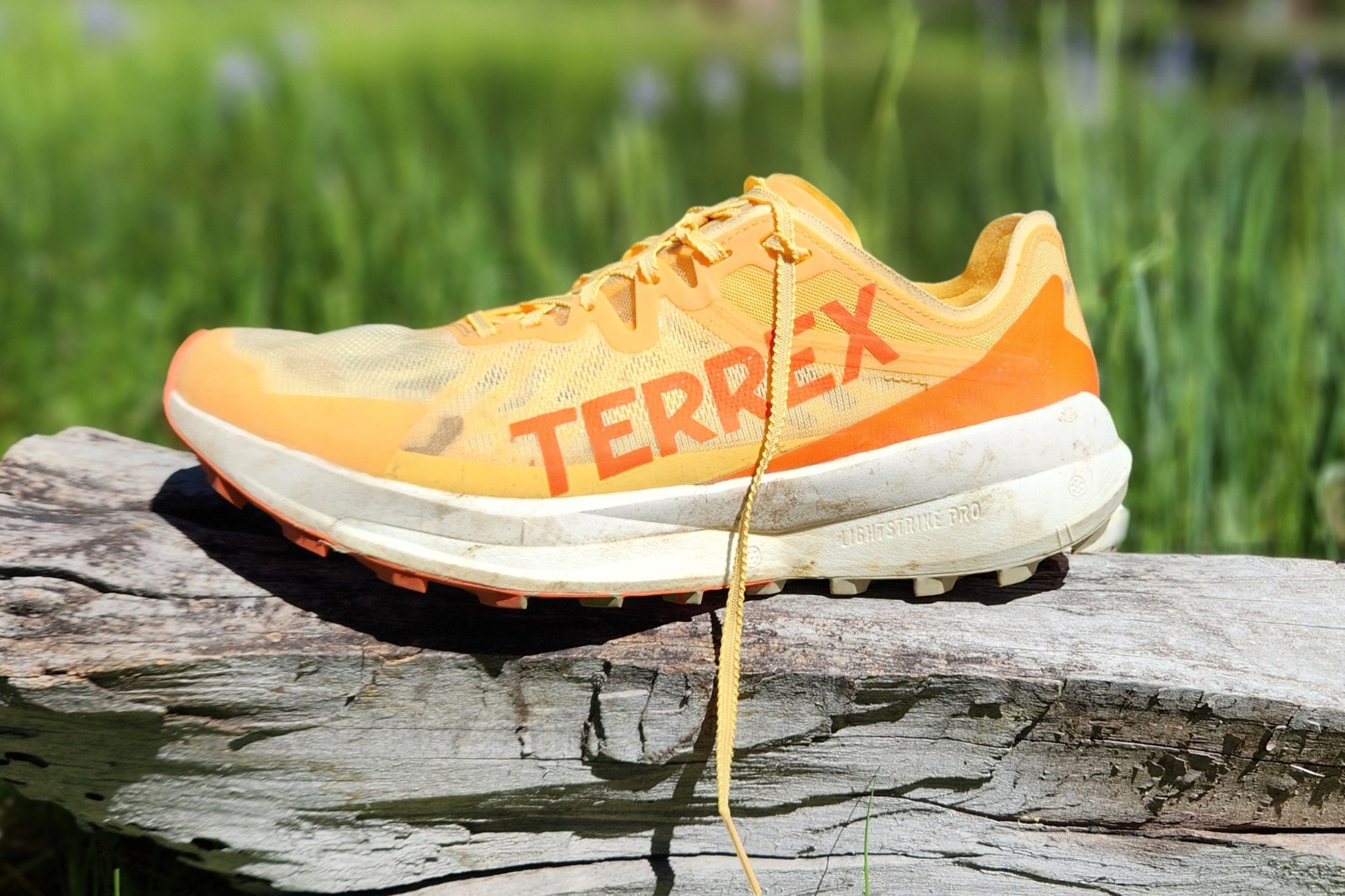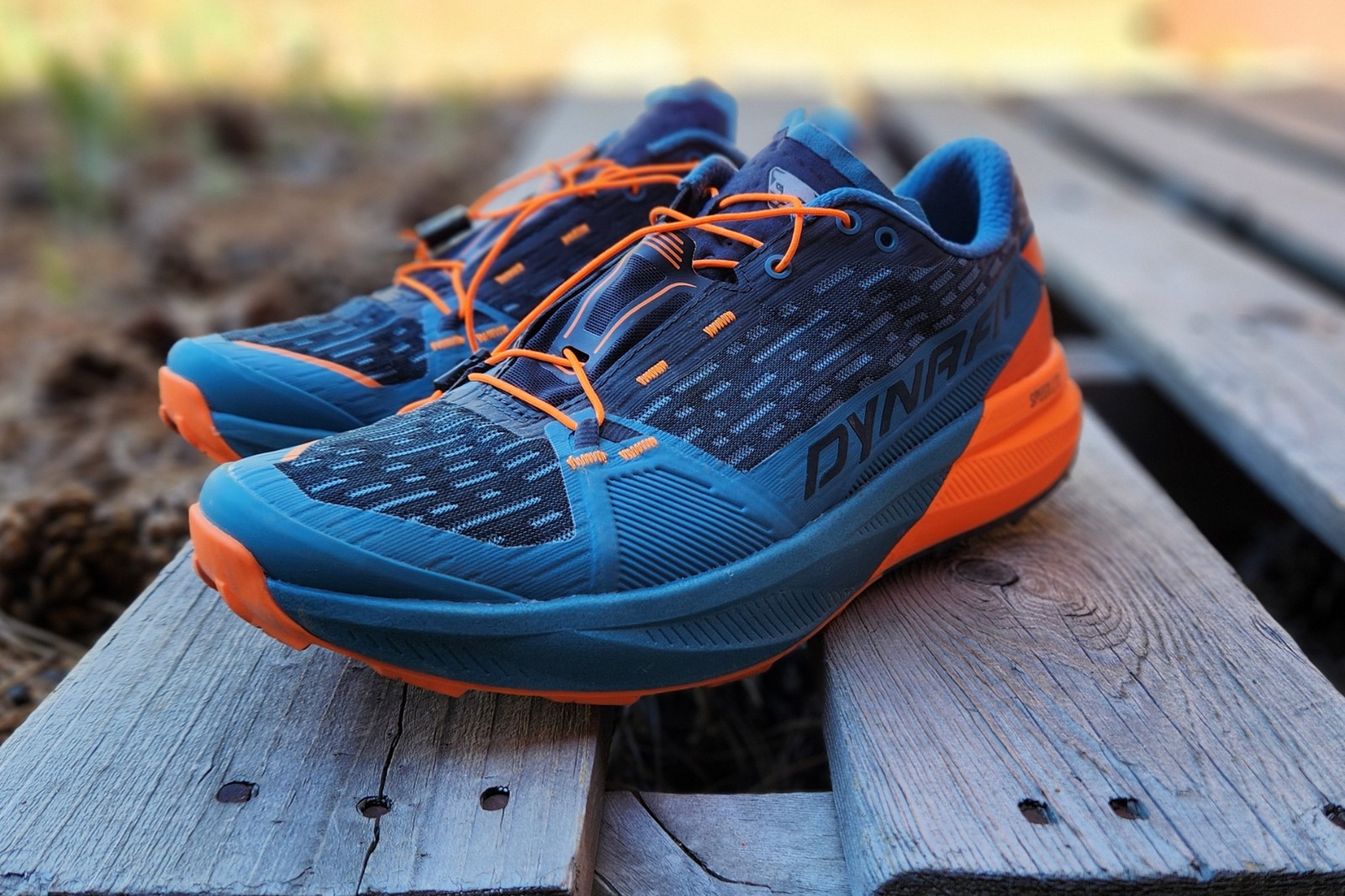
We independently review everything we recommend. When you buy through our links, we may earn a commission.
10.5 oz. (299 g) for a US M9,
9.5 oz. (270 g) for a US W7
35 mm in heel, 27 mm in forefoot (8 mm drop)
Big-time Ultra racing
Vibram Megagrip outsole, Speedlite midsole, QuickLace system
Available now for $190















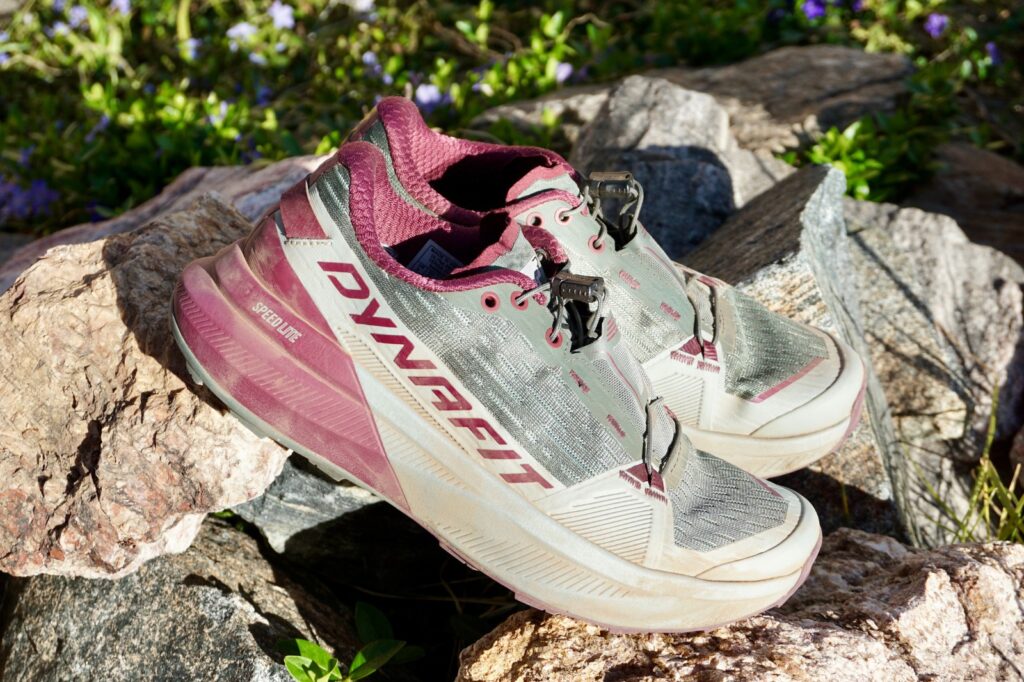
REESE: When Dynafit comes to mind, it’s all about high-performance alpine touring skiing with a distinct Euro vibe and visions of the Swiss Alps. While Dynafit has long been a leading ski brand, for me, its footwear has often fallen just short of expectations. Yet, over time, the brand has been steadily refining and investing more in its mountain running and ultra-running gear.
Now, enter the Ultra Pro 2, the latest evolution of Dynafit’s long-distance mountain running shoe. Featuring a generous 35 mm of Speedlite cushioning in the midsole, this shoe delivers maximum comfort for those epic mountain excursions. And with the Vibram Megagrip outsole, you might just feel invincible tackling Alp-like peaks (alright, maybe that’s a slight exaggeration).
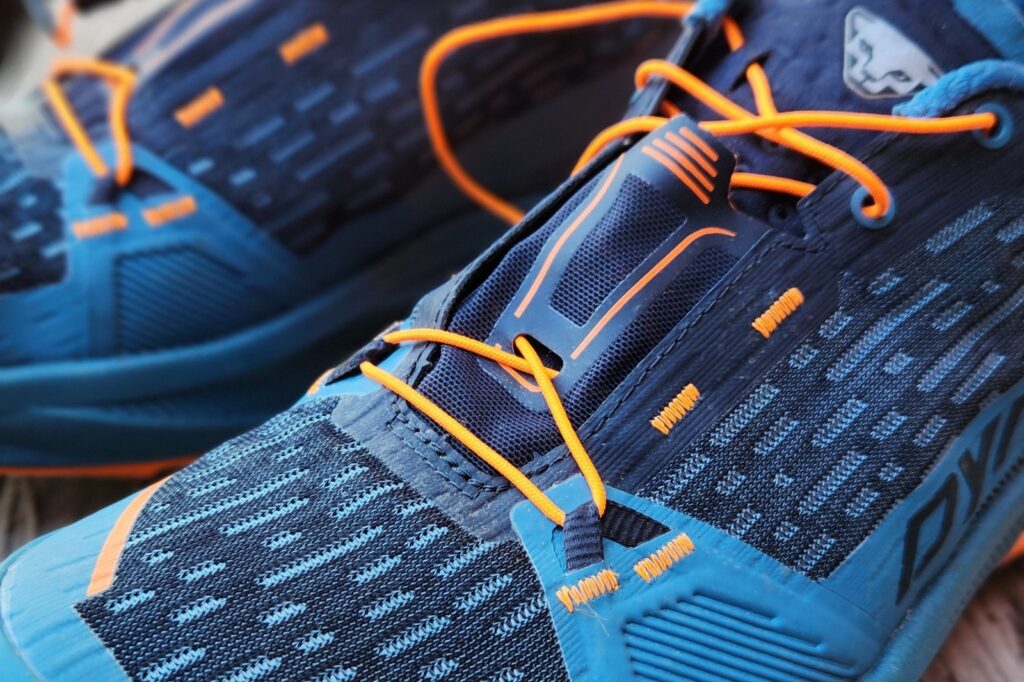
TAYLOR: Reese is right. Dynafit is synonymous with high alpine vistas and cortados. The European aura cannot be shaken, and that’s how it should be. The Austrian company knows technical terrain thoroughly, and all of its products are designed distinctly for mountain travel. Being that I live in the mountains, anything that comes my way from Dynafit does get me pretty excited.
Our first experience with the brand was back when the first iteration of the Ultra 100 launched. It was a promising shoe for the time and one of the few higher-stacked shoes that could roll around comfortably in technical terrain. That particular shoe is what the Dynafit Ultra Pro 2 reminds me of most. It feels much more like an update to that shoe than any of its actual predecessors. There are easy, direct connections between the shoes, and that doesn’t bother me one bit.
Keep in mind that the Ultra Pro 2 was created as an ultra-distance mountain running shoe, which means various terrain, conditions, and paces are necessary. That’s a tall task for any shoe.
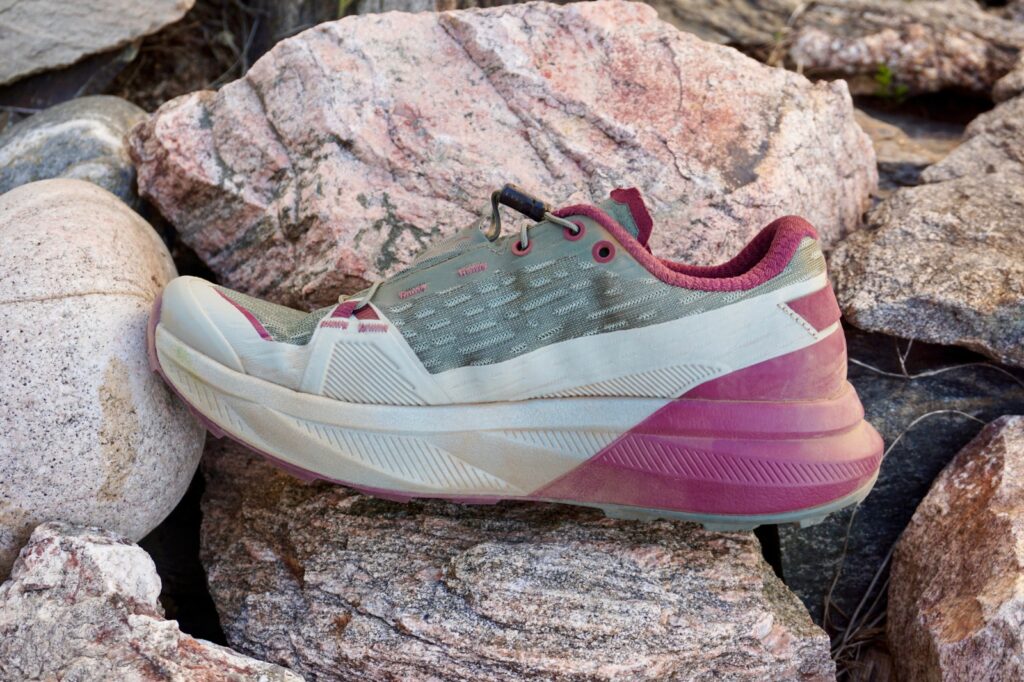
REESE: I expected this shoe to fit like my ski boots, incredibly tight with no room for movement. I was pleasantly surprised to find out this wasn’t the case. The designers had comfort in mind when making the Ultra Pro 2. In fact, it has a surprising amount of room in the toe box and through the midfoot (good and bad, we’ll get to that later). The padding on the tongue was also a pleasant surprise.
Dynafit uses a quick lace system, which simply means there isn’t that annoying instance where you want the lower laces to be tighter, but to do so, you have to go through the whole process of untying the laces and working the slack up the lace pattern. With the quick lace system, you aren’t tying laces or double knotting anything. You can easily snug the quick lace system down with uniform pressure across the top of the foot. Worried about hot spots from this? I was, too, but thanks to a pretty pillow tongue on the shoe, there is plenty of padding between your foot and the laces to keep you feeling fine.
Another feature, though I’m not sure it’s a true feature, is the stability and the neutral ride of this shoe. Often, with max cushion shoes, there’s a lot of correction to the foot landing pattern that happens or overly large/wide platforms to compensate for the egregious amount of foam, which often loses its integrity over time. The Ultra Pro 2 didn’t have any of that nonsense, it’s just a neutral shoe with durable, one might even say dense, foam that doesn’t boss you around.
Lastly, it’s worth noting that the Vibram Megagrip outsole is insanely robust and durable. Like, after the apocalypse destroys almost everything — it’s going to be the cockroaches and that Megagrip rubber left on this planet.
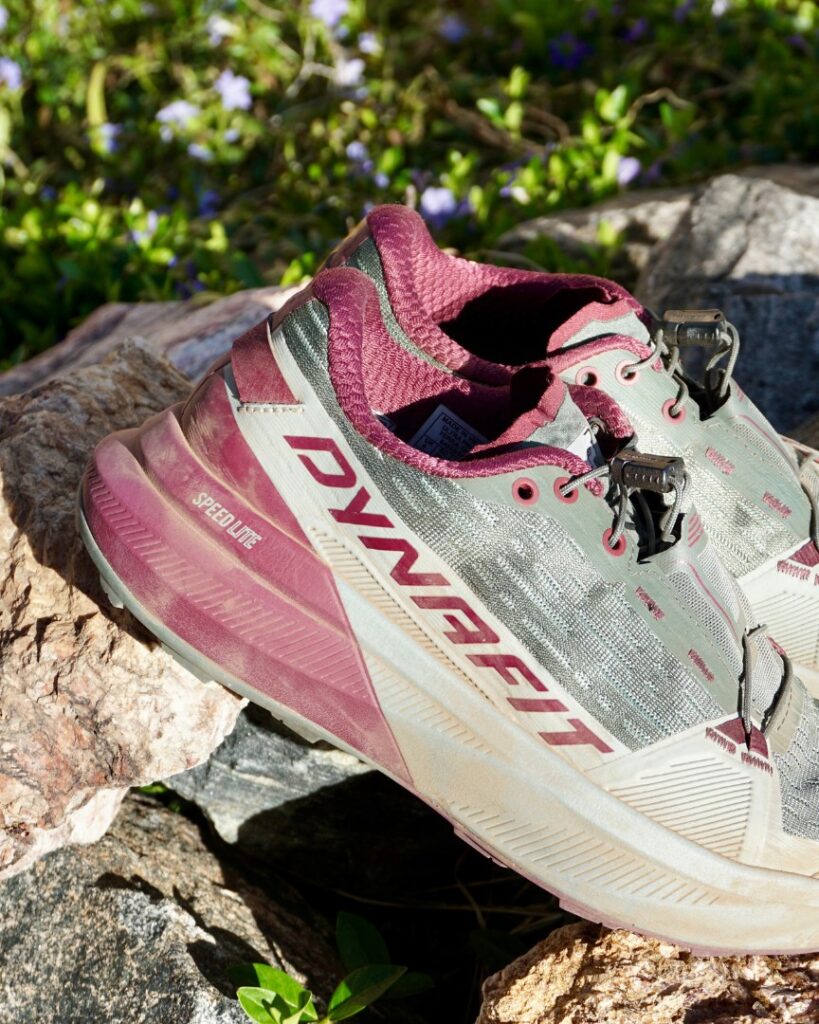
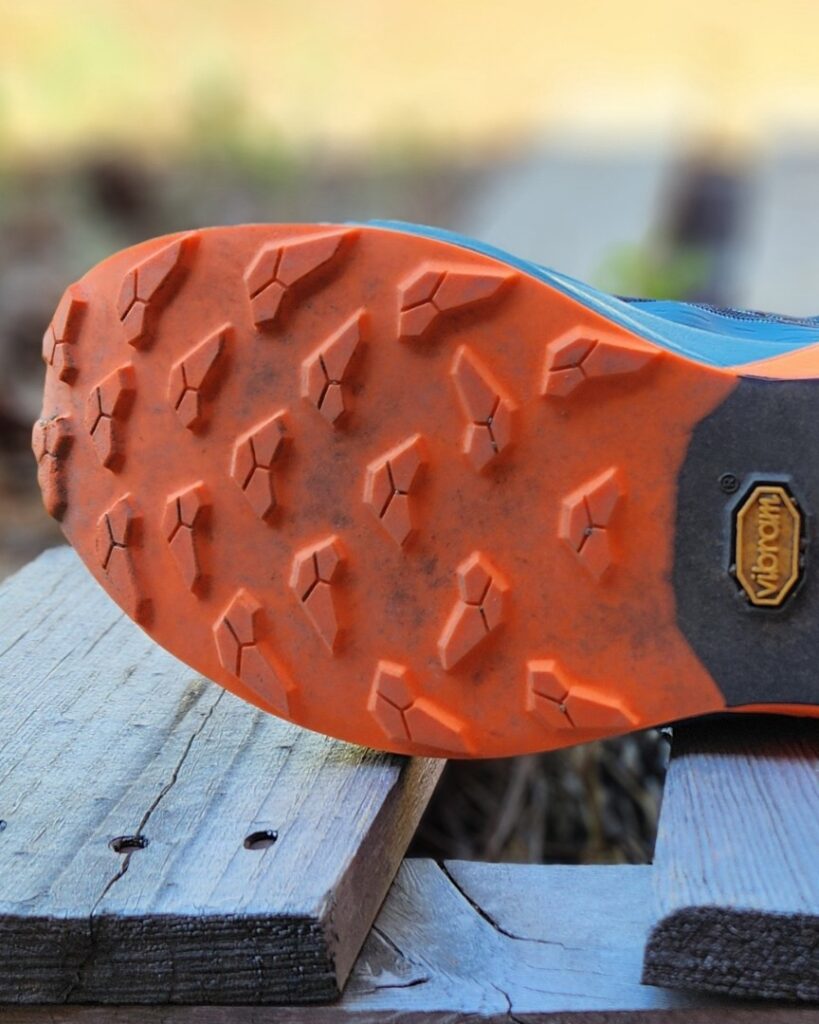
TAYLOR: Normally, I’d put a shoe like this into the max cushion category, but I think a more appropriate descriptor would be max protection. Normally, that kind of statement would make you think this shoe is going to be a brick, but I promise that’s not the case with the Dynafit Ultra Pro 2.
Case in point, the new Speedlite foam is a welcome addition to Dynafit’s growing quiver of shoes. The brand used Speedlite Plus in its race-day pick, the DNA Ultra, and now we see a standard form of Speedlite with similar density properties. There’s no getting around the fact that this midsole is dense — like corn and beef fed dense. It’s where the protection comes from. By today’s standards, the Dynafit Ultra Pro 2 has a high stack (35/27 mm), but it has the protective properties of something that has even more foam, like the Brooks Caldera 7 or Speedland GS:PDX. It certainly punches above its weight in terms of protection, and the ground feel was basically non-existent.
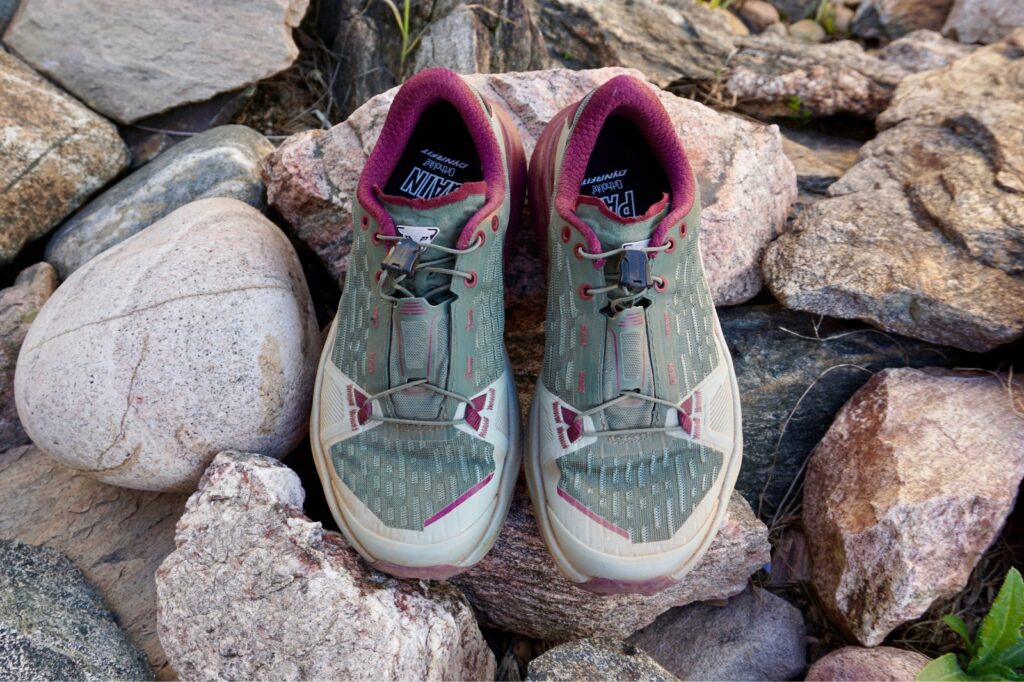
The Dynafit Ultra Pro 2 also scores high marks for durability. Sure, it comes with a break-in period, which is a bit of an anomaly these days, but it was much needed — and appreciated — this time around. What was initially a firm, solid ride slowly softened and settled into a much nicer medium-to-firm sensation that stuck around. I really didn’t mind the ride, especially once it softened enough to conform to the trails yet maintained a profile that I could be confident in on varied terrain. You could probably compare it to the Brooks Cascadia, Hoka Speedgoat 6, and La Sportiva Akasha II.
Dynafit’s wide profile and rockered geometry also help to get the most out of the Speedlite foam. The efficiency measures are a must-have with any shoe marketed as ready for an ultra. Further, the natural stability will help to keep you going, no matter what distance your mildly deranged trail-running mind is set on. As already mentioned, the consistency that the Dynafit Ultra Pro 2’s midsole offers over time will be the main draw for runners.
Durability will be a common theme throughout the Ultra Pro 2 — its Vibram Megagrip outsole is a tried and true strong performer, no doubt about it. Dynafit believes heavily that full coverage is the only way to go. The heavy-duty tacky rubber is a no-brainer for the terrain and distances that this shoe is intended for. The 3.5 mm lugs have been questioned once or twice, but they served me well in my miles through a variety of conditions. They simply lack the ability to get the shovel out and dig when conditions are thick.
A unique woven engineered mesh upper with strategic overlays around the forefoot and heel will also provide a consistent fit for runners. The upper materials combine to provide a very tenacious, secure, and comfortable experience — aspects that don’t always pair well. This should be no surprise from Dynafit.
Overall foot security is a staple in Dynafit products. They’re made for mountain travel and fit as such. I felt confident on moderate to technical terrain in this shoe. The whole heel area of the shoe was well-structured and well-padded. Surprisingly, the tongue is not gusseted but masterfully cushioned so that I can cinch up on the speed lace system without saying goodbye to blood circulation. Honestly, I wish this heel construction was in their high-end DNA Ultra shoe.
Shop The Shoe - Men Shop The Shoe - Women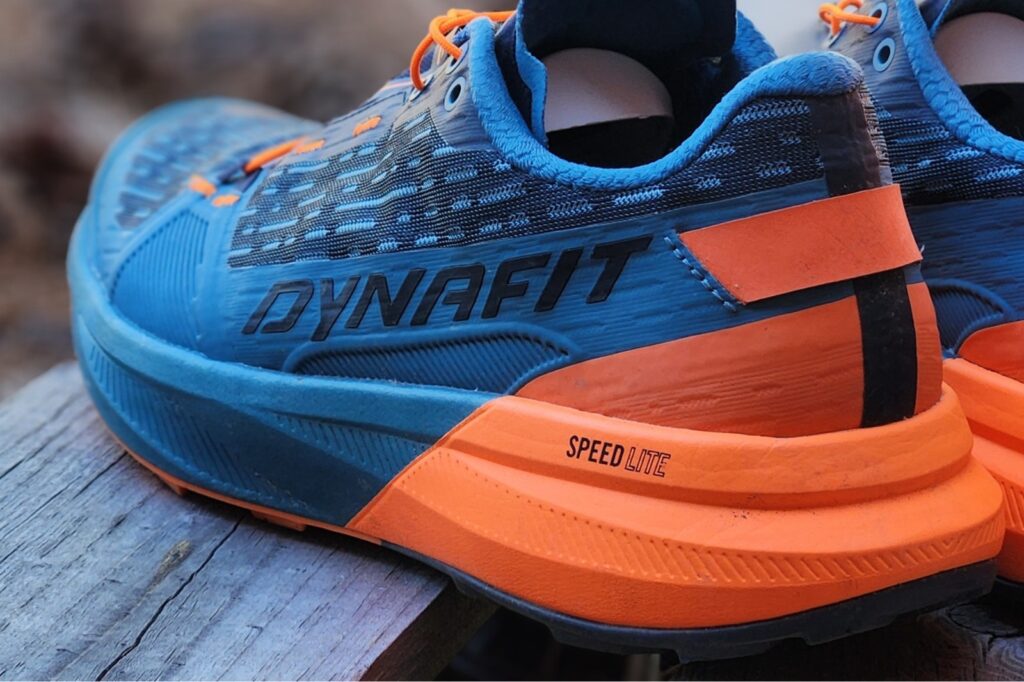
REESE: For an everyday trail shoe, I think the Ultra Pro is a bit too clunky. It feels like it would be most at home on trails that run up technical mountains. I want something that doesn’t make me feel slow on the flowy trails or gravel paths of Fort Collins. (Hey, we all gotta boost our egos somehow, helloooo carbon plates.) I mean, the sole of the shoe has Megagrip rubber and 3.5 millimeters lugs. Do I need Megagrip on flowy single track? Unlikely. In a Crique Series race? Definitely. And while I appreciate that it’s not overly narrow, it is a high-volume shoe. I ran with medium arch inserts from Spenco, and I still had to really cinch down the laces to feel secure in the shoes. That being said, if you’re someone who needs a robust shoe with plenty of interior living space, this might suit you well.
The lace garage felt a bit too overly engineered to me. A simple bungee would have worked fine, but this was one part dirt-repellent and one part lace garage. Dynafit gave all the room to the interior and left no room for wiggle, literally, for storage in the garage. What is a garage for other than storing things? Considering that its not a very giving housing system, I’m not sure how one relaces the shoe laces, as Dynafit provides normal laces for those of you who don’t want the quick lace system.
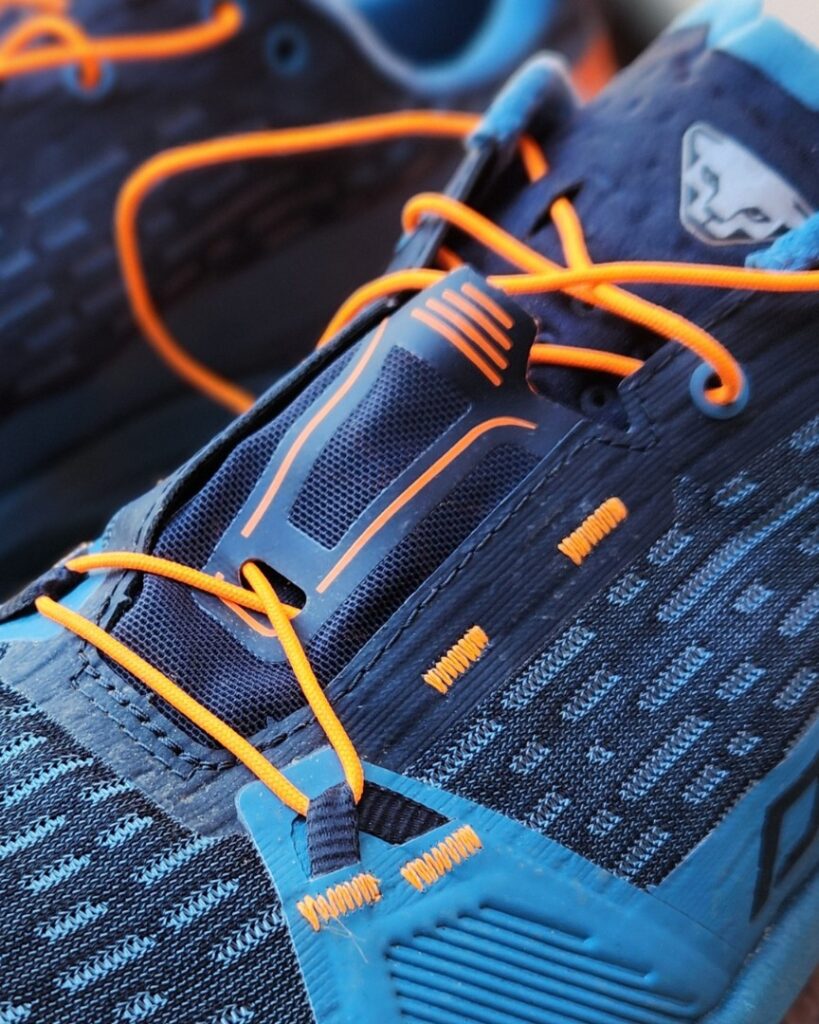
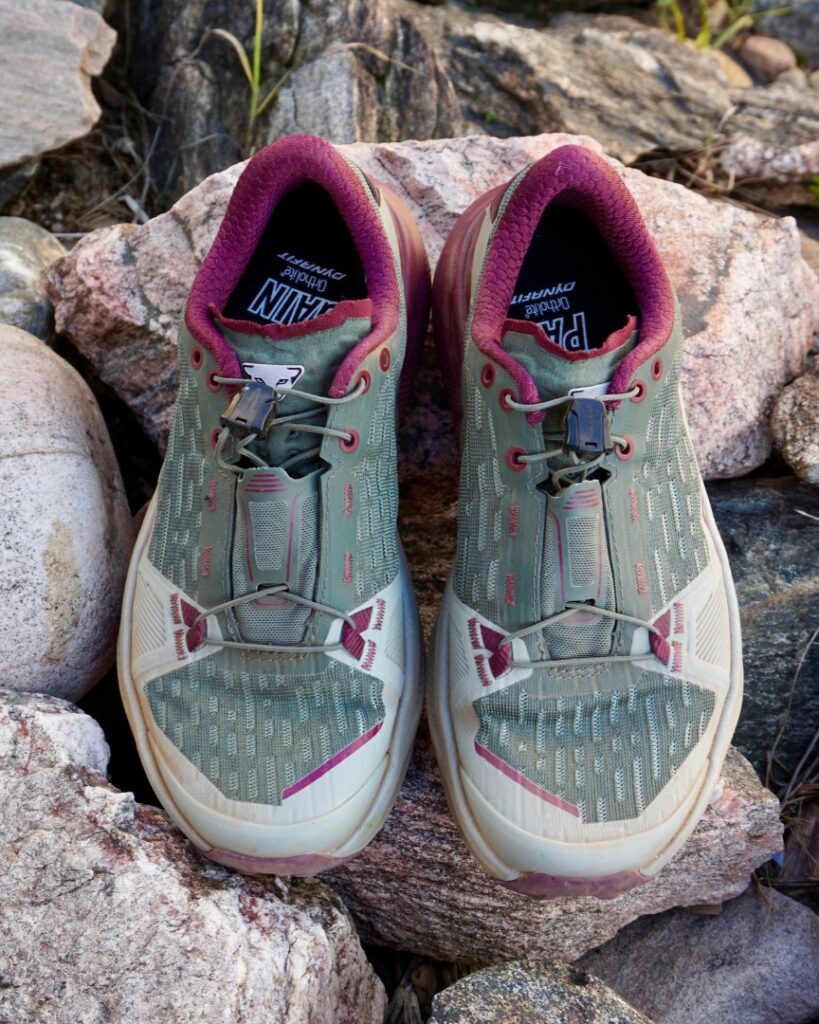
TAYLOR: One thing runners will notice immediately is that the Dynafit Ultra Pro 2 is a heavy shoe. A lot of that comes from the dense midsole and high build quality. There’s a lot of material here, so it’s not all for terrible reasons. The weight combined with the break-in period did concern me a little bit because the shoe kind of clunked along until it softened up. Thereafter, it still felt weighty but much more functional.
I am typically a men’s 10.5, but the rule of thumb for Americans is to go at least a half size up for Dynafit shoes. My sample men’s 11 came in at 12.7 ounces. It’s easily the heaviest shoe on my shelf… even heavier than the Speedland GS:PDX and Brooks Caldera 7. It seems unnecessarily heavy when compared to other shoes in the same stack category like the Hoka Speedgoat 6 (10.3 oz), Merrell Agility Peak 5 (11.4 oz), NNormal Tomir 2.0 (10.7 oz), VJ Maxx 2 (9.4 oz), Saucony Endorphin Rift (9.8 oz), Norda 001 (10.7 oz), and Topo Athletic Mtn Racer 3 (10.9 oz).
Even though I felt the half-size up was necessary to find the right fit, I still had to work to keep my foot in an optimal position within the shoe. The heel construction is a little weird. The heel counter is angled forward more than most shoes. If I cinched up my shoe loosely, the heel counter would push my whole foot forward and make the toe box seem shorter than it actually is. Now, it does have a stumpy toe box for sure, which is why it was so crucial for me to cinch the lacing system quite tightly near the top of the lacing chain to pull my heel back into its pocket and keep it there. If I could achieve that to avoid foot crunchage (it’s a word, okay!), the whole shoe gave much more positive vibes.
Lastly, just like with the Dynafit DNA Ultra, the Ultra Pro 2 caused some irritation on my forefoot because of the lower lacing chain anchors. They are stitched in and have an adhered overlay. Because they fell right on top of my metatarsal joints, there was some discomfort and visible irritation. Over the long haul, what was annoying became bothersome, and you can imagine how that will cascade over hours and hours in the shoe. Both thicker socks and lube helped in the case but never completely halted it.
Shop The Shoe - Men Shop The Shoe - Women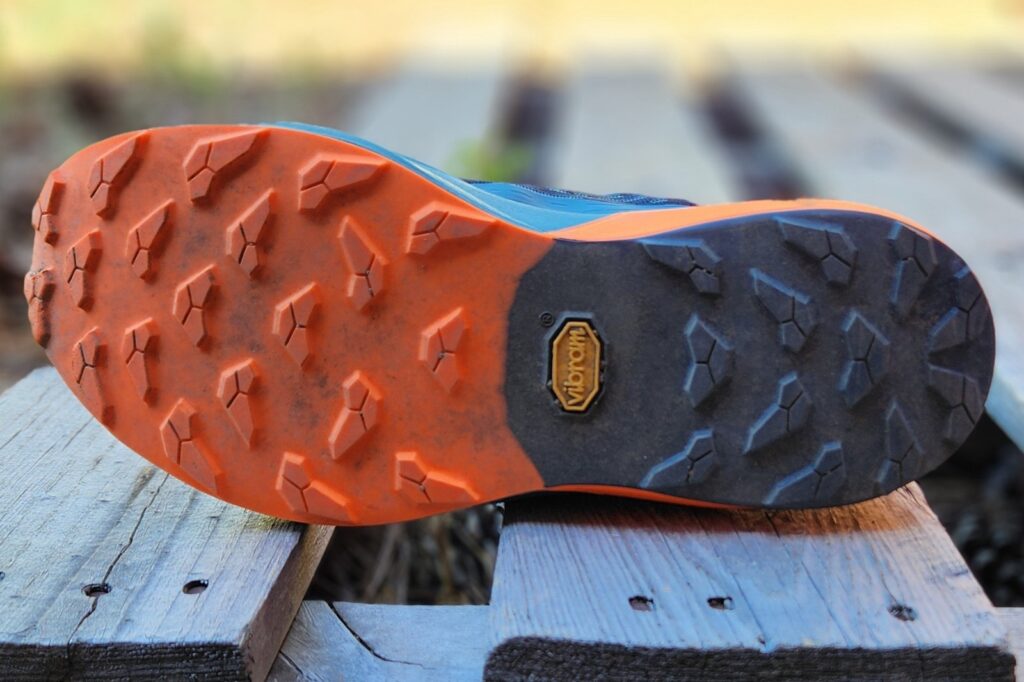
REESE: The Dynafit Ultra Pro 2 is a shoe that wants to be in the Alps. It doesn’t want to be on flowy single track, that’s for beginners. After all, pro is in the name. This shoe is incredibly specific and likely well-suited for technical mountain races and those who want a little extra grip on their shoe, room in the toe box, and European clout. It’s worth noting that Dynafit has always had issues with sizing, and that remains true with this shoe. I went a half size up, and that felt like the right fit for me.
I wish this shoe were just a little less beefy and a little more… I don’t know… more salami, more Bündnerfleisch? That’s not quite right. I forget what I’m talking about now and need a snack. Anyway, the shoe could use a little more responsiveness and spring in its step to be a more all-around ultra-distance shoe, not just those elusive ultras that only go up and down mountains. The stiffness of the Megagrip makes me doubt whether this shoe would, in fact, be good for ultra distances. Considering my feet felt broken after wearing the Catamount (both the OG and the 3), I have reservations about running for a long time in this shoe.

TAYLOR: Consistency is a major theme with the Dynafit Ultra Pro 2. It’s a perfectly good descriptor for a shoe that is aimed at being an ultra-distance trail runner. Sure there are some areas of improvement, mainly in the comfort department, but this shoe will not be afraid or unable to take runners the distance. The Ultra Pro 2 boasts foot security, a fairly smooth ride, and protection to take you anywhere, too. I feel that this shoe is a good attempt to broaden Dynafit’s scope of trail running options. At the same time, as Reese said, the Dynafit Ultra Pro 2 wants and needs to be in the mountains to be at its best.
To be frank, as long as irritation can be kept at bay, this shoe has a lot of good things going for it as an ultra shoe or a very solid hiker too.
You can pick up the Dynafit Ultra Pro 2 for $190 by using the buttons below.
Shop The Shoe - Men Shop The Shoe - WomenHave something to say? Leave a Comment

Reese Ruland is a Fort Collins, Colorado-based ultra trail runner with over 15 years of competitive running experience. She has a penchant for PopTarts, a gear addiction, and is always taking photos of her two French Bulldogs, Loaf and Oatie. In addition to her athletic endeavors, Reese serves as an ambassador for Project Heal, a nonprofit organization dedicated to promoting accessible mental health care for those affected by eating disorders. She’s also one of the fastest women ever to run R2R2R (7:59).
More from Reese
Taylor Bodin is a trail and ultra runner living in Estes Park, Colo., with his wife and daughters. As the head of the Dirt Division at Believe in the Run, trail running is pretty much the only hobby he can manage right now and loves it. Every so often, he will pop off a race or FKT attempt because competition is pure and the original motivator for him getting into running anyway.
More from Taylor